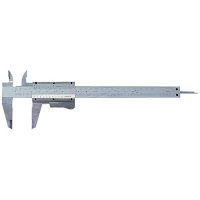Below are examples of the scientific concepts I have learnt:
1) Scientific Method. This term I have learnt about the scientific method. The scientific method is used to answer true-false questions. There are 6 steps in this method. To summarise it quickly, it is just 'Observation', 'Question', 'Hypothesis', 'Method', 'Result', 'Conclusion'. After having a conclusion, we can always repeat the experiment so as to see if the results are reliable. At first, I had no idea what the scientific method was but now, I know that the Scientific Method is important as these are the basic steps when doing an experiment. It will aid me through when I am planning an experiment.
2) Measurements. This term, I was being exposed to many different instruments used for measuring, for example, the metre rule, micrometer screw gauge, test tubes etc. However, what caught my attention the most was the vernier calipers. Before Mr Tan had shown me that apparatus, I had never even heard it, let alone seen it before. The vernier calipers can be used for measuring the external and internal diameter of an object and also the depth of the object if necessary. After the many diagrams and some demonstrations by Mr Tan, I finally understand how accurate this apparatus is. I have also learnt how to use it and how I should read the reading when it is measuring the internal and external diameter of an object. Finally, I could also understand what the zero error is and how I can read the reading off despite a zero error.
 |
| Vernier Caliper |
3) Lab hazards. This topic was basically quite easy. There were 6 lab hazards I learnt so far. They are radioactive substances, biohazards, toxic substances, corrosive substances, flammable substances and irritants. I have also learnt the symbols that represent each hazard and some safety precautions for each of them. For example, when handling corrosive substances, we should wear gloves and handle it in a fume cupboard.
Well, should we learn science just for the sake of doing well in our exams? Definitely not, science can also be useful and relevant in the world around us. Here are some examples:
Measurement: When measuring things, I have already thought that the ruler is the most useful. However, after looking at other apparatus, I realised that there are actually many other apparatus that are more accurate than that. For example, the micrometer screw gauge can measure up to 0.001cm. This is one of the most accurate apparatus that I know of. This also teaches me to measure things accurately in life and not to give too many estimations because a small difference could cause different results.
Volume: When you order a cup of coke filled with lots of ice, you may think that this is fair but it actually is not. There was once when my brother ordered a big cup of coke and he finished it in less than 3 minutes. I was puzzled and asked him how he could finish drinking it so fast, then he replied me saying he had no idea. Therefore, I looked at the cup again and I realised that there were still many particles of ice in it. I finally understood. Ice occupies space so by putting lots of ice in the cup, not only will there be a lot less coke in the cup, the drink will still look very appealing. This shows that science is also applicable in life, even in simple things like buying a drink.
 |
| Coke filled with ice |
Lab hazards: By knowing the different lab hazards can some safety precautions against it, we can help to advise our family members on what to do right. For example, when there is some gasoline near my brother and he is doing an experiment with the need to use fire, I can advise him not to do it near the gasoline as it is a flammable substance. If the gasoline catches fire, it might be dangerous for him as well.
1) Solar system. I was first introduced to the solar system in Integrated Humanities where my IH teacher had given me some videos related to the solar system to watch. I was fascinated by the different colours and planets in space. Hence, I decided to do more research on the solar system for example how big each planet was and if any living things could be existent on it. When I was young, I remembered watching cartoon shows on Pluto exploding or disappearing in space that is why it is not a planet. Well, now I know it is not true. Pluto is not a planet because it is too small and light and it did not fulfil the last criteria, which is "clearing the neighbourhood" out of its orbit.
 |
| Solar system |
2) Atomic Clock. This is the most accurate clock in history. It was invented by English physicist Louis Essen in the 1950’s. Atomic clocks maintain an accuracy up to 10−9 seconds per day. The atomic clocks works based on atomics physics and the microwave signal that electrons in atoms emit.
 |
| Atomic Clock |
3) Pycnometer. I was interested in the variety of apparatus, hence, I went to check up on other kind of apparatus. The Pycnometer is also called ‘specific gravity bottle’. This is an apparatus used to determine the density of an object. It is usually made of glass, with a glass stopper attached to it. Although I do not know how it actually works, I will still continue to find out more about it.
 |
| Empty Pycnometer |
No comments:
Post a Comment